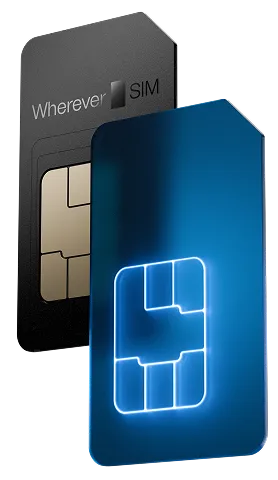

In the Internet of Things, millions of devices communicate with each other - often battery-powered and in hard-to-reach places. This is exactly where LPWAN technologies come into play: they enable energy-efficient, cost-effective and long-lasting connectivity. Two key standards are NB-IoT and LTE-M. But which technology is right for your project?
LPWAN (Low Power Wide Area Network) stands for mobile communications standards that are optimized for low data rates, low power consumption and long range. Ideal for IoT applications with sporadic data transmission such as sensors, smart meters or trackers.
In the cellular environment, two 3GPP-compliant LPWAN standards, NB-IoT and LTE-M, have become established, which are based on mobile networks and therefore also offer the necessary network quality and scalability in professional applications.
Whether a project can be operated successfully in the long term depends largely on the right connectivity. If you choose the "wrong" mobile communications standard at the start, you may face problems later on, such as a poor connection in the event of obstacles or unnecessarily high energy consumption.
This is precisely why it is worth taking a closer look at the differences and making a realistic assessment of which technology suits which application.

NB-IoT (Narrowband-IoT), also known as LTE Cat NB1, is a mobile technology specially developed for the Internet of Things. It is particularly suitable for stationary applications where small amounts of data rarely need to be transmitted. The strength of NB-IoT lies above all in its energy efficiency and its ability to ensure a stable connection even in hard-to-reach places. One of the reasons why NB-IoT works reliably even in shielded environments such as basements or technical rooms is the so-called low-frequency principle: radio waves that are transmitted in low frequency ranges, as is the case with NB-IoT, have a longer wavelength. These long waves penetrate walls, floors and other structural obstacles much better than high-frequency signals.
devices that are connected via NB-IoT also require very little power. So little, in fact, that they can be operated for up to ten years on a single battery. This makes NB-IoT the ideal solution for sensors, meters or other devices that need to operate for years with little maintenance.
NB-IoT also has advantages in terms of range and the ability to penetrate walls or building structures: A reliable connection can even be established in underground garages, basements or remote areas with difficult radio conditions. At the same time, the technology offers a very high network density. This means that several hundred thousand devices can be operated in parallel in a single radio cell without interference.
These properties make NB-IoT the preferred choice for many classic IoT applications such as smart metering, parking lot sensors or the monitoring of environmental parameters. There are limitations in terms of data rate and latency: large amounts of data cannot be transmitted efficiently and real-time applications are unsuitable due to the comparatively high delay. NB-IoT is also only suitable for mobile applications to a limited extent, as it is not possible to seamlessly switch cells, for example when objects are moving.

In contrast to NB-IoT, LTE-M (LTE Cat M1) is designed for IoT scenarios that require fast response times, a higher data rate and mobility. The technology is based on the 4G network and is already available in many countries today. At the same time, it is future-proof, as LTE-M can also be operated in 5G networks with a simple software update.
A key feature of LTE-M is its low latency: data can be transmitted within milliseconds, allowing applications to react in near real time. Even large amounts of data - for example when tracking assets or in wearables - can be sent and received without any problems. In addition, LTE-M enables seamless switching between radio cells (handover), so that even devices in motion can establish a stable connection at all times. This makes LTE-M ideal for mobile use cases where location changes and continuous data flows are required.
Another plus point is the support of voice services via VoLTE, which is particularly relevant for safety-critical applications such as emergency call systems in vehicles or elevators. Although LTE-M consumes slightly more energy than NB-IoT and offers lower building penetration, users benefit from greater functionality, real-time communication and broad network availability, especially in Europe and North America. LTE-M is therefore usually the better choice for projects where mobility, low delay and voice communication play a role.

Niedrig (< 250 kbit/s)
High
Very low
Mittel (< 1 Mbit/s)
Low
Low
Very good
No
Yes (VoLTE)
Only with external hardware
Integrated (with network support)
Partially, still under construction
Widely available in LTE networks
Smart meters, sensors
Tracking, wearables, mobile control
Restricted
Good
Fully supported
The choice between NB-IoT and LTE-M is not a technical end in itself, but directly influences the efficiency and scalability of a project. The decisive factor is the specific application. A hybrid strategy can also make sense for certain scenarios, e.g. with multi-band modules that use NB-IoT or LTE-M depending on the location.
The choice between NB-IoT and LTE-M is not a purely technical decision, but depends largely on the specific deployment scenario of your IoT application. To identify the right connectivity solution, it is worth asking three key questions:
Themovement pattern of your device plays a decisive role. When it comes to a stationary application - such as a water meter in the basement, a permanently installed temperature probe or a parking lot sensor - there is a lot to be said for NB-IoT. This technology is specially designed for static installations and scores points for its long range and high signal availability in areas that are more difficult to access, such as underground car parks and basements.
The situation is different if your device regularly changes location or is constantly on the move, such as when tracking supply chains, in wearables or in mobile machines. In such cases, LTE-M is the better choice as it is handover-capable: the device can switch between radio cells without interruption and always remains connected.
In short: Mobile = LTE-M, stationary =NB-IoT
Anotherfactor is the amount of data that your device should transmit and the intervals at which this happens. If you only need to transmit small data packets at regular intervals, such as with a fill level sensor or a smart meter, NB-IoT is ideal. The technology is designed to send small amounts of data over longer periods of time while saving energy - perfect for applications where energy efficiency is more important than speed.
If, on the other hand, larger data streams need to be transmitted continuously, such as position data in real time or status messages from more complex machines, LTE-M has the advantage. The higher bandwidth and lower latency enable faster, more stable and bidirectional communication.
In short: Low, periodic data = NB-IoT, continuous data flow =LTE-M
Thephysical location of your device also influences which technology is more suitable. In environments with poor network coverage - such as basements, industrial halls or rural areas with many structural obstacles - NB-IoT really comes into its own. The high building penetration ensures that there is still a reliable connection even where other standards have already reached their limits.
If, on the other hand, your device is on the move flexibly, such as in a vehicle, in changing locations or in combination with global roaming, LTE-M offers the necessary network flexibility. With the ability to switch between radio cells and use voice or SMS services, you are ideally equipped for mobile and dynamic scenarios with LTE-M.
In short: Underground, shielded = advantage NB-IoT, network flexibility on the move = advantage LTE-M
Regardless of the chosen wireless standard, the reliability of an IoT project stands and falls with the right SIM card.
Our M2M SIMs already support NB-IoT and LTE-M in numerous countries and offer non-steered roaming, real-time management via a web portal and flexible tariff models. This means that even complex rollouts can be managed efficiently and scaled in a future-proof manner.

